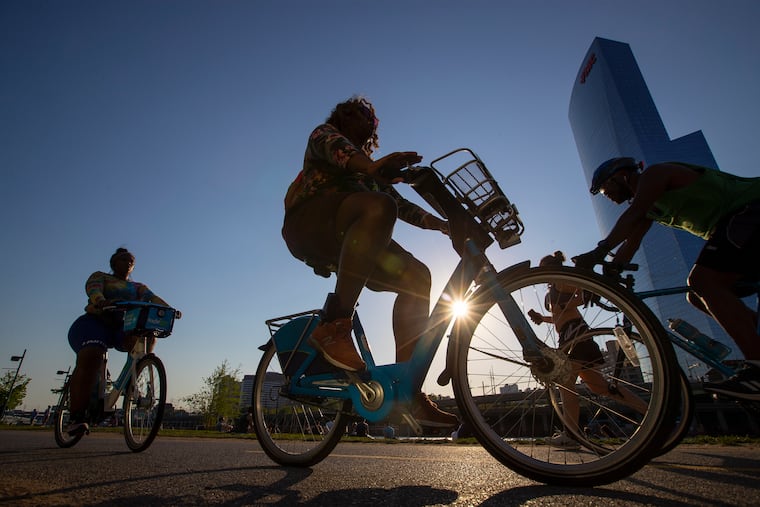Forecasters see blistering summer despite cool start. But about those spring outlooks ...
Forecasts suggest one of the warmer summers on record, but it was a tough spring for the meteorologists.

As if the prospect of contending with the coronavirus fallout weren’t vexing enough, the forecasts are suggesting that the summer will be hotter than usual, unkind to home-energy bills, and potentially deadly around here.
Publicly available outlooks are calling for temperatures above normal during the three-month meteorological summer, which begins Monday, which would translate to one of Philadelphia’s warmest summers on record. (The “astronomical summer” will begin June 20.)
But before you work up a cold sweat, keep in mind that this was one fabulous spring — if you’re a fan of human fallibility and the limits of computer intelligence.
» READ MORE: Winter forecast has mild outlook for Philly and most of the nation, continuing warming trend
For the long-range forecasters, April and May provided abject lessons in humility. For the first time in 17 years, both months finished with below-normal temperatures in Philadelphia, about 2.5 degrees in both cases. Cool was the rule also in other parts of the country. If anyone saw that coming, our apologies.
In March, for example, AccuWeather Inc. was predicting a possibly unprecedented run of spring warmth across the country. The government, the Weather Channel, and the Commodities Weather Group also missed the marks.
» READ MORE: Philly’s gloomy weather has been matching the national mood. And it might be about to get worse.
Instead, given the chill, the volatility, and remarkably mild winter, “It seems like we’ve had six months of March,” Frank Strait, an AccuWeather senior meteorologist, said last week.
Those summer outlooks
AccuWeather’s summer forecast appears to be the most bullish on heat, calling for average temperatures as much as 3 degrees above long-term averages in Philadelphia in July and August, in which case it would rank among the warmer in the period of record dating to 1874.
“You’re going to have plenty of hot weather, especially in July and August, and probably a greater frequency of 90-plus days,” Jack Boston, Strait’s colleague, said Sunday.
On average, Philadelphia has 24 such days annually. Of more concern would be hot nights, which are especially dangerous for the elderly and vulnerable in the city’s rowhouse neighborhoods.
And the AccuWeather outlook favors high humidity, which retards cooling by inhibiting the escape of daytime heating after dark.
Sea-surface temperatures in the Atlantic are above normal, and that would favor those big “Bermuda highs," areas of high pressure centered over the ocean, he said. Winds circulate clockwise around centers of high pressure, and winds from the south to the west of the center draw sultry tropical air northward.
The Weather Co., parent of the Weather Channel, is also going warm for the summer. Meteorologist Todd Crawford suggested that could be correlated with La Niña, or widespread cooling, expected over the Tropical Pacific. La Niña correlates with warmth in some parts of the United States.
The Commodity Weather Group, which serves agricultural interests, has just about the entire country above normal for the summer.
The government’s Climate Prediction Center sees odds favoring a warmer summer in most of the nation, save for a belly of temperature uncertainty sagging in the middle of the country where wet soil might hold off heat.
Big factors in its outlooks are the trends, and the trends clearly have been in favor of warmth. In Philadelphia, the average June 1-to-Aug. 31 temperature in the 21st century, close to 77 degrees, is about 2 degrees higher than the 20th century’s summer temperatures.
Climate change is a prime suspect. Worldwide temperatures have increased at the rate of about 0.3 degrees Fahrenheit per decade since 1981, according to the National Centers for Environmental Information, with the 2019 global temperature about 1.7 degrees higher than it was in the 20th century.
The trend method, however, has limits, cautions Mike Halpert, the center’s acting director. It’s a trend, until it isn’t. If you stay with it, he said, “some years you’re going to be woefully wrong.”
About those spring forecasts
“The historically higher-than-normal temperatures this winter appear to have been just the star," AccuWeather said in a news release in March, and it predicted "higher-than-normal temperatures over the next three months throughout the United States.” AccuWeather CEO Joel Myers stated. “This may be a first.”
Myers, a veteran meteorologist, is credited with the “rubber band” theory; when the atmosphere is in an abnormal state, it ultimately will snap back.
That happened in April. All winter the cold had been bottled up in the Arctic by a powerful polar vortex, and it eventually broke loose.
“We didn’t count on how cool it was in late April and early May,” Boston said.
AccuWeather had plenty of company. The government had odds favoring a warm April, and stayed with it when it updated its forecast on March 31. It also had a warm May, although it adjusted the outlook at the end of April.
The Weather Co. predicted a warm April and May for here and most of the nation. The Commodity Weather Group came closest; it said it would be close to normal.
Is this so hard?
Evidently, yes.
Long-range outlooks continued to wrestle with the reality that the atmosphere is a nonlinear chaotic system, and that what works for short-term forecasts doesn’t apply beyond about 10 days, and that is a generous estimate.
In the very short term, it is safe to say that the next few days will feel like September with highs in the 70s, but it might sneak past 90 on Wednesday.
Let the summer commence.